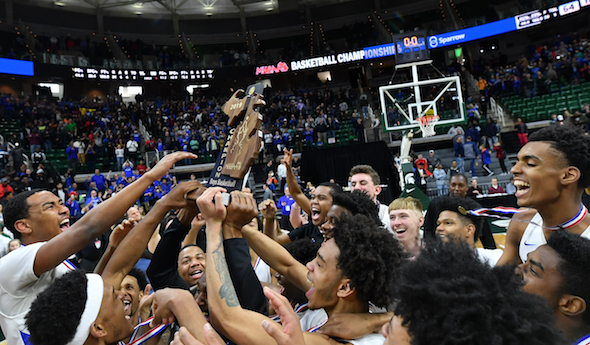
Lincoln Beats Buzzer for 1st Basketball Title
By
Paul Costanzo
Special for MHSAA.com
March 16, 2019
EAST LANSING – All eyes were on Ypsilanti Lincoln freshman Emoni Bates on Saturday as the seconds ticked away in the Division 1 Boys Basketball Final.
None were on Lincoln senior Jalen Fisher. But that all changed when the buzzer sounded.
Fisher’s rebound and jumper as time expired gave the Railsplitters their first MHSAA boys hoops title with a 64-62 victory over U-D Jesuit at the Breslin Center.
"At the beginning of this game, I just told (Fisher) to be patient, your time is coming man, be patient,” Lincoln coach Jesse Davis said. “During the timeouts I said, ‘Jalen be patient, your time is coming.’ I didn’t know it was going to come like that, but I’m glad it happened to him, because I believed in him the whole time.”
The last-second shot was the first to win a championship game featuring the state’s largest schools – formerly Class A, now Division 1 – since Lansing Sexton defeated Hamtramck in overtime in Class A in 1959.
Fisher’s shot ended a dramatic final quarter, which saw Lincoln (23-4) rally from a nine-point deficit. The Railsplitters took possession of the ball in a tie game with 1 minute, 20 seconds remaining, and drained the clock to set up a final shot.
That shot was supposed to be for Bates – considered the top freshman in the country – who gathered the ball in the backcourt but was immediately doubled as he came across half court.
“We trapped him, trying to get the ball out of his hands,” U-D Jesuit coach Pat Donnelly said. “I thought they got a decent, a clean look up top, but it was forced way out. That was what we talked about going in, that we were going to double (Bates) if he caught the ball.”
Bates passed out of the double team to senior teammate Amari Frye, who launched a 3-pointer from the top of the arc. He thought it was good – he remarked he thinks every shot he takes is good – and so did Fisher, but it hit the side of the iron and caromed to a wide open Fisher who capitalized with the game-winner.
“I thought it was good, but it hit the top of the rim and came in my hands, so I just shot it and it was good,” Fisher said. “I just shot it, and when it went in, I just saw black. Then I saw people on top of me. It was a good feeling though.”
Fisher, who played all 32 minutes and finished with 16 points, fell immediately to his back after hitting the shot and was mobbed by his teammates near the Lincoln bench.
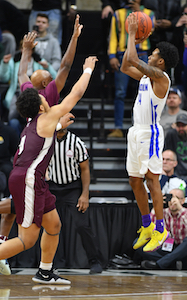 “I talk to my kids about living in the moment, and this was a moment that nobody saw coming but us,” Davis said. “I just think it’s great to have some kids you can take and you start with them when they’re freshman – Amari, Tahj (Chatman), Jalen came when he was a junior – but I’ve been instilling a championship mentality in Tahj and Amari for four years. Then we add somebody like Jalen with exceptional speed, toughness and a will to win, then you add somebody like Emoni Bates who can carry us through tough games and make big shots, and do everything the other guys couldn’t do. It just came out so beautiful, man.”
“I talk to my kids about living in the moment, and this was a moment that nobody saw coming but us,” Davis said. “I just think it’s great to have some kids you can take and you start with them when they’re freshman – Amari, Tahj (Chatman), Jalen came when he was a junior – but I’ve been instilling a championship mentality in Tahj and Amari for four years. Then we add somebody like Jalen with exceptional speed, toughness and a will to win, then you add somebody like Emoni Bates who can carry us through tough games and make big shots, and do everything the other guys couldn’t do. It just came out so beautiful, man.”
The Cubs (25-3) led for most of the game and nearly all of the second half after taking an 11-point lead into halftime. Daniel Friday scored 19 points, while Julian Dozier added 18 and six assists to put their team in control and up 60-51 with five minutes to play.
But Lincoln fought back and went on an 11-0 run, taking a 62-60 lead on a Frye layup with 1:38 remaining. Dozier responded immediately with a layup of his own to tie the game, but the Cubs wouldn’t see the ball again in the final 1:20.
“We’re the same kind of team as them; we score points in bunches,” Davis said. “We can get on a run and score. We’re capable of making runs just like them, so I keep telling my team, ‘Hey, keep doing what we do, keep applying pressure on both ends, and some shots will go down for us.’”
Bates scored in spurts himself, finishing with a game-high 23 points despite not having his best shooting night (7-of-22 from the floor and 1-of-7 from 3-point range). He was 8-of-8 from the free-throw line, however.
The Cubs played Friday on Bates for much of the game. Friday was giving up five inches to the 6-foot-9 Bates, but had a 45-pound weight advantage. Jordan Montgomery, who was giving up more than a foot in height, also countered with strength.
“(The U-D Jesuit defense) was good, but I just wasn’t making shots today,” Bates said. “I was getting to my spots, but my shot just wasn’t falling.”
Bates also had six rebounds and three blocks for the Railsplitters, while Frye finished with 15 points.
Montgomery added nine points, all on 3-pointers, for the Cubs, while University of Massachusetts-bound senior Jalen Thomas had six points and seven rebounds.
“I want to congratulate Ypsilanti Lincoln on a tremendously hard-fought victory – they're a good team,” Donnelly said. “Coming into this game we heard all this stuff about, ‘You have to stop Emoni, stop Emoni,’ but we were a lot more concerned with more than Emoni. They have some good players out there.”
PHOTOS: (Top) Ypsilanti Lincoln celebrates its first MHSAA boys basketball championship Saturday at the Breslin Center. (Middle) Jalen Fisher launches the game-winning shot as the final seconds tick off the clock in the Division 1 Final.
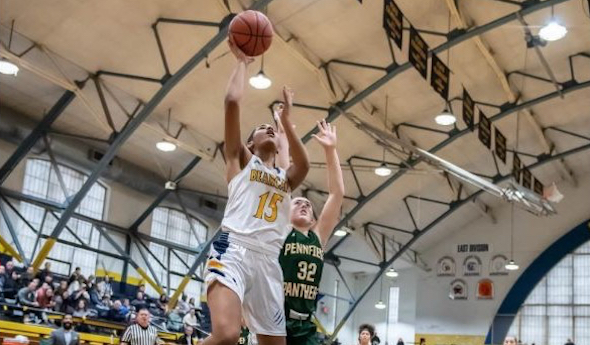
Hoops Finds Annual Home During Holidays
December 27, 2019
By Ron Pesch
Special for Second Half
Nothing says the Holidays like a high school basketball tournament.
It started, like many things do, with a drip. Well, make that a dribble.
The Michigan High School Athletic Association has allowed Holiday basketball tournaments for years. When was the first? That’s hard to establish. No one really kept track of such. A 1934 Wakefield News article indicates that a “Christmas Tournament will be held for the (Gogebic) Range teams at Wakefield December 27 and at Ironwood December 28.” Hurley, Bessemer, Ironwood and Wakefield were entered in the “blind” tournament, with opponents drawn just before game time. It was a new idea, at least in the Upper Peninsula.
“Nothing of its kind has ever been attempted in the Peninsula before,” stated the Ironwood Daily Globe. The tournament, won by Hurley, was a financial success. After expenditures, including the purchase of trophies, profit equaled enough that $22.42 was distributed to each school competing in the tournament. Plans were announced to bring back the tournament in a larger format the following year. It did return the following December, with the same teams in the same format but with all games played in Wakefield. This time out, Ironwood topped Hurley 22-21 for the tournament title.
In the Lower Peninsula in 1935, an All-Berrien County Holiday tournament was held Dec. 26, 27 and 28, with Three Oaks winning the Class B-C division title, 15-13 in the final over Berrien Springs. St. Joseph Catholic emerged as the Class D victor with a surprising 27-26 win over the reigning MHSAA state champ from Stevensville. The 14-team competition was played at Niles High School. Attendance was “slim, very slim” for the opening day of the tourney. The event did not return in 1936.
A similar, but much smaller, event was staged in Berrien County in 1941 with the Bridgman Class C Invitational. The tournament featured seven teams with contests spread over three nights. It was a success.
“Some 450 paid admissions were checked in Wednesday night for the championship finals, which Bridgman won from Berrien Springs. … The total paid admission for the three night event was 1,420 fans with a gross gate of approximately $400.”
By the mid-1940s, the idea of playing prep basketball during the Christmas lull had begun to take off across the state.
In December 1946, before a crowd of 1,500 at the Flint IMA Auditorium, Holland, the reigning Class A champion, downed Flint Northern 51-48 behind a pair of late field goals by Ken ‘Fuzz’ Bauman in the first annual Motor City Invitational. In Jackson, Detroit Catholic Central won the Michigan Catholic Invitational, beating Kalamazoo St. Augustine, 42-40. Bridgman again snagged the title at the Sixth Annual Berrien Class C Christmas Holiday Tournament. It was the Bees’ third Christmas championship in four years. The Little Eight Conference Holiday Tournament was played across four school gymnasiums as the calendar transitioned from 1946 to 1947. Bangor downed Covert, 34-29, in the championship contest hosted at Watervliet High School on Saturday, Jan. 4.
“Holiday tournament basketball has really caught on in Michigan,” said Hal Schram in the Detroit Free Press in 1947. “There will be no Christmas-New Year’s rest for at least 60 Michigan high school squads which have jumped at the chance to sharpen their collective shooting eyes for the long season ahead. … At last count, tournaments will be played between Dec 17 and Jan 3 at Flint, Saginaw, Grand Rapids, Jackson, Lincoln Park, Fremont, Negaunee, Marquette, Benton Harbor and Detroit.”
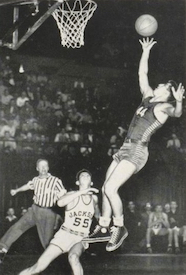 The same eight schools that played at the first Motor City tournament – Jackson, Grand Rapids Central, Holland, Muskegon Heights, Monroe, Midland, Flint Central and Flint Northern – were invited back for the second year. According to Schram, “Not a single participating school of a year ago wanted to be left out.”
The same eight schools that played at the first Motor City tournament – Jackson, Grand Rapids Central, Holland, Muskegon Heights, Monroe, Midland, Flint Central and Flint Northern – were invited back for the second year. According to Schram, “Not a single participating school of a year ago wanted to be left out.”
Jackson downed Flint Northern in the title game, 39-34.
The Saginaw Invitational, hosted at Arthur Hill High School, boasted six Class A schools as well as Alma and Mount Pleasant, both Class B schools. Mount Pleasant surprised the field, winning the tournament with a 40-25 triumph over Dearborn Fordson in the championship game.
A year later in December, Schram wrote, “The Michigan High School Athletic Association wasn’t caught unaware when the tournament bug started to bite every sector of the state.”
“Never did we expect such a wave of tournament play as we will see during the next three weeks,” said Charles Forsythe, state director for the MHSAA, noting 34 Christmas vacation tournaments were scheduled between December 15 and January 8 during the 1948-49 basketball season. “Perhaps we’re lucky at that. The Oklahoma association has had to sanction 123 tournaments.”
Forsythe and Schram explained the reasons for the wave of popularity. Of particular interest was the fact that, at the time, a school sponsoring both football and basketball could play a total of no more than 24 games, combined, in the two sports. However, MHSAA rules allowed a basketball team the chance to play as many as three games during a Holiday tournament and be charged with only one of its allotted combination of 24 contests. (The MHSAA rules changed prior to 1972-73 to allow basketball teams a maximum of 20 games.)
Coaches could keep their squads sharp during the two-week layoff with games rather than just mandatory practices. And, as a bonus to all because tournaments were financed through gate admissions, invitations to larger tournaments meant teams got to “stay and eat at the best hostelries, go on sightseeing tours when not playing and play non-conference opponents from other sections of the state.“
Add in the chance to play before larger-than-normal crowds, and the formula for a successful tournament was cast.
Beginning with the 1950-51 season, the football-basketball rule was altered to count play in mid-season invitational tournaments as two contests. With the change, according to the Detroit Times, “the number of such meets dropped sharply.”
Only nine Holiday tournaments, involving 50-plus teams, were recorded by the MHSAA during the 1951-52 season: the 5th annual Flint Parochial Invitational, the Alpena Catholic Invitational (involving 16 teams), the 5th Annual Greater Lansing Invitational, the Albion College Invitational, the Twin-Five Conference Christmas Tournament (a 10-team replacement for the disbanded Little Eight Conference’s tournament), the Otisville Invitational, the Columbiaville Invitational and the 1st Annual Portland St. Patrick Christmas Invitational.
But by the 1960s, Holiday Tournaments were again regaining popularity, with more now focused on teams from a specific community or section of the state, especially among smaller schools.
The St. Patrick tournament was still going strong in 1966 – its 15th year – with an eight-team, four-day design. Williamston downed a Cinderella squad from Carson City, 64-44, before 1,100 fans at Portland to earn the championship. Other Mid-Michigan holiday tournaments played out in Chelsea and Swartz Creek at the same time.
The Flint Parochial League Tournament was a mainstay of the Holiday season until the breakup of the league in the early 1970s.
“Basketball tournaments have become popular around the state and nation in recent years,” wrote Wendy Foltz, longtime Battle Creek Enquirer sports editor, before the kickoff of the inaugural Battle Creek Central Holiday Cage Tournament in 1968. In a twist that harkened back to earlier days, the eight-team event represented nearly every section of lower Michigan. “Battle Creek never has been a rabid basketball town like some around the state,” added a hesitant Foltz, noting a hope that the event could at least break even.
Hosted at the Cereal City’s historic Fieldhouse, built in 1928, that first tournament was won by host Battle Creek Central, which downed Traverse City 71-53 before a crowd of 2,000. Phil Todd led the Bearcats with 29 points, including 21 in the first half, while 6-foot-8 Tom Kozelko paced TC with 24. Muskegon Heights won the consolation game, holding off a late Ypsilanti Willow Run rally, 78-77. Other schools competing were Battle Creek Lakeview, Grand Blanc, Romulus and recently-opened Jackson Lumen Christi.
Chuck Turner, Central’s head coach, and junior varsity coach Jack Schils had contacted 60 schools during the summer of 1967 to organize the 12-game schedule.
“The response was terrific,” said Schils, who added, “Many schools could not accept because of schedule commitments but want to enter a year hence.”
The Battle Creek tournament was back in 1969, again hosting teams from near and far. Schils noted that cost ran high when teams were brought in from long distances: “However, this type of tournament is highly desirable so we hope fans will support it.”
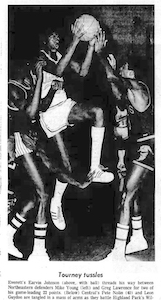
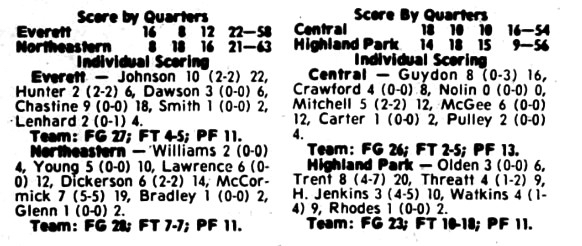 But the event was discontinued following the 1970-71 season when the “eight team format became too unwieldy,” according to the Enquirer “… and both crowd and the quality of play declined.”
But the event was discontinued following the 1970-71 season when the “eight team format became too unwieldy,” according to the Enquirer “… and both crowd and the quality of play declined.”
Pared down to a four-team format, it returned in a big way in December 1975. The tournament saw standing-room-only crowds of more than 3,000 for games between Battle Creek Central, Detroit Northeastern, Class A quarterfinalist Lansing Everett and reigning Class A champion Highland Park.
Detroit Northeastern downed Lansing Everett, 63-58 for the Cereal City championship trophy. Everett junior Earvin Johnson scored 22 points and, with teammate Reggie Chastine, was named to the all-tournament team along with Northwestern’s Wilbert McCormick, the tourney MVP, and his teammate Greg Lawrence. Highland Park’s William Trent and Battle Creek Central’s Leon Guydon also were named to the team.
By the 1980s, it seemed that the Christmas break nearly mimicked March in Michigan.
“I think a Christmas tournament really helps your program,” said Turner in 1980 to the Enquirer. He had taken over the head coaching position at Battle Creek in the fall of 1967 after a successful stint at Willow Run. “I don’t understand basketball teams having a preseason, playing three or four games, then taking two weeks off. When you get back, it’s like starting over.”
Besides Turner’s squad, the 1980 field included Detroit Western, Detroit Murray Wright and eventual winner Kalamazoo Central. The event would ultimately be re-christened the Battle Creek Central Chuck Turner Holiday Classic.
“The late Chuck Turner started bringing big games to the city over the holidays when he first started at the school in the 1960s,” wrote Bill Broderick in the Enquirer in 2018.
“Chuck started this because he wanted to give people the chance to come back home for the holidays and see everyone play. It’s been like a family reunion over the years,” Fred Jones told Broderick. Jones was a longtime assistant to Turner. “That we can keep it going in his name is great and hopefully we can keep if going for another 50 years.”
The girls are now part of the action. All five Battle Creek city schools – Central, Pennfield, Harper Creek, Lakeview, and St. Philip – were part of the event in 2018.
This year the Chuck Turner Central Field House Holiday Classic will again span two days – December 27 and 28 – and will again see all five city schools play on the historic floor.
Other Holiday tournaments scheduled this year include:
Petoskey Invitational – December 13-14
Raider Shootout – December 21
18th Annual Muskegon Area Sports Hall of Fame Classic – December 27
Earl McKee Classic – December 27-28
North Farmington Holiday Extravaganza – December 27
Motor City Roundball Classic – December 27
Cornerstone Invitational – December 27
Washtenaw Hoops Showcase – December 28
 Ron Pesch has taken an active role in researching the history of MHSAA events since 1985 and began writing for MHSAA Finals programs in 1986, adding additional features and "flashbacks" in 1992. He inherited the title of MHSAA historian from the late Dick Kishpaugh following the 1993-94 school year, and resides in Muskegon. Contact him at [email protected] with ideas for historical articles.
Ron Pesch has taken an active role in researching the history of MHSAA events since 1985 and began writing for MHSAA Finals programs in 1986, adding additional features and "flashbacks" in 1992. He inherited the title of MHSAA historian from the late Dick Kishpaugh following the 1993-94 school year, and resides in Muskegon. Contact him at [email protected] with ideas for historical articles.
PHOTOS: (Top) The Battle Creek Central and Pennfield girls face off during the 50th Chuck Turner Classic. (Middle) Shaheen Shaheen scores two points for Flint Northern, which fell to Jackson 39-34 during the 1947 Motor City championship game. (Below left) Lansing Everett’s Earvin Johnson makes a move toward the basket against Detroit Northeastern during the 1975 Battle Creek event. (Below right) Box scores from the 1975 tournament include Johnson’s 22 points in the 63-58 loss. Photos courtesy of the Battle Creek Enquirer, Lansing State Journal and Ron Pesch archives.)

